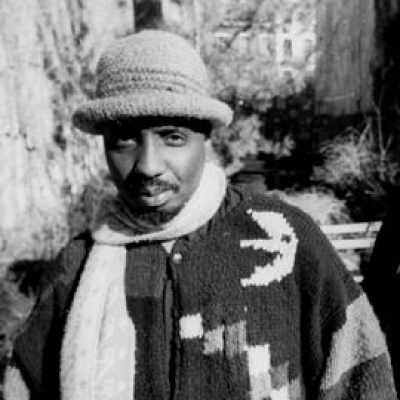
William Parker
by Chris Kelsey In the early 90s, the direct musical heirs of Taylor, Ayler, and Coleman were mostly ignored by New York jazz critics, who found more to like about the hard bop revivalists who dominated major-label recording. Hence, the public visibility of musicians devoted to an energy music aesthetic was minimal. Despite its low profile, however, that strain of free jazz was kept alive by a fairly large group of Lower East Side musicians, many of whom gathered around the musics pre-eminent bassist, William Parker. Parker was the scenes major catalyst for musical activity. With his wife, dancer Patricia Nicholson, and other downtown free players such as drummer Jackson Krall and pianist Mark Hennen, Parker founded the Improvisers Collective, an organization that presented free jazz in combination with other types of spontaneous performance. Beginning in 1994 (and continuing in one form or another as of this writing), the collective produced a well-received series of concerts and festivals that featured some of the citys finest free improvisers — saxophonists Marco Eneidi, Sabir Mateen, and Daniel Carter, trumpeter Lewis Barnes, and pianist Cooper-Moore, to name a few. Parker was the fulcrum of the collective; he played in nearly all of its various ad hoc groups, and led the Collectives enormous big band, which later recorded under Parkers name as the Little Huey Creative Music Ensemble. As a bassist, Parker is possessed of a formidable technique, albeit an unconventional one. Unlike a great many jazz bassists, Parker was not formally trained as a classical player, though he did study with three of the finest jazz players of the 60s, Jimmy Garrison, Richard Davis, and Wilbur Ware. Consequently, Parkers style is based on a tradition of self-expression and experimentation. His arco work is possibly the most fascinating aspect of his idiom; Parker excels at the creation of dense, hyperactive streaks of color, gleaned from the inherent harmonic properties of the instrument. At bottom, he is a textural player. Lyricism plays a secondary role in his work, with or without the bow. Parkers pizzicato style is overwhelmingly percussive, in intent and effect. Though he does, to an extent, serve as a harmonic anchor in his groups, his more important role is as a source of energy. Parker drives a band like few other bassists; in combination with a powerful drummer, a Parker-led rhythm section is an inexorable force. Parker grew up in New York City. Very early in his career he formed an association with Cecil Taylor; Parker played Carnegie Hall with the pianist in the early 70s. Parker released his first album as a leader in 1979. Through the Acceptance of the Mystery Peace (on Parkers own Centering Records) featured saxophonists Charles Brackeen and Jemeel Moondoc and violinist Billy Bang. Parker became Taylors regular bassist in the 80s. He played on several of the pianists European records, and on Taylors most recent domestic major-label release, 1989s In Florescence, on A&M. Parker left Taylor in the early 90s and began working more often as a leader. He recorded a big-band record for his own label, then began releasing a series of CDs for other companies, significantly Black Saint. Besides his activities as a leader and community organizer, Parker would continue to work as a sideman through the mid-90s; he remained the bassist of choice for downtown free players like David S. Ware, Matthew Shipp, and Rob Brown. 2000 was particularily busy for Parker as he recorded three of his own dates (Mayor of Punkville, Painters Spring, and ONeals Porch) and appeared on numerous other recordings as sideman.
